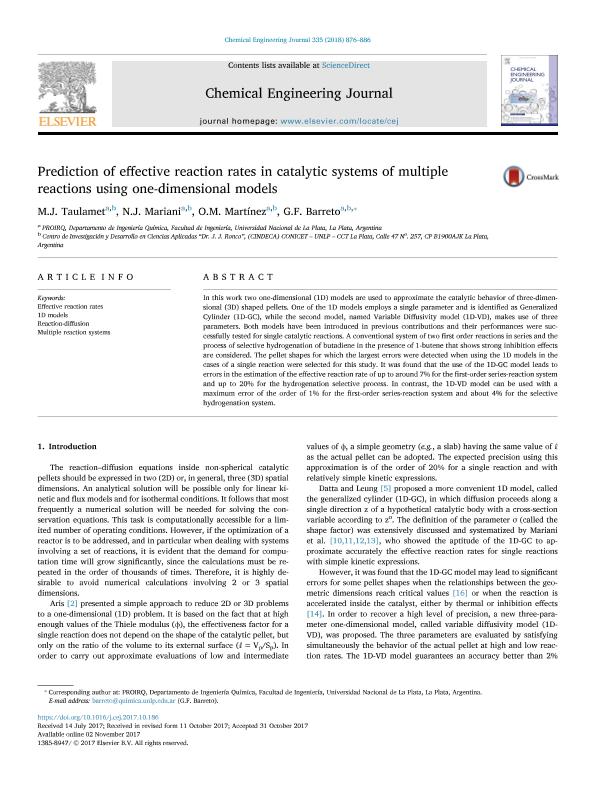Artículo
Prediction of effective reaction rates in catalytic systems of multiple reactions using one-dimensional models
Taulamet, María José ; Mariani, Nestor Javier
; Mariani, Nestor Javier ; Martinez, Osvaldo Miguel
; Martinez, Osvaldo Miguel ; Barreto, Guillermo Fernando
; Barreto, Guillermo Fernando
 ; Mariani, Nestor Javier
; Mariani, Nestor Javier ; Martinez, Osvaldo Miguel
; Martinez, Osvaldo Miguel ; Barreto, Guillermo Fernando
; Barreto, Guillermo Fernando
Fecha de publicación:
03/2018
Editorial:
Elsevier Science Sa
Revista:
Chemical Engineering Journal
ISSN:
1385-8947
Idioma:
Inglés
Tipo de recurso:
Artículo publicado
Clasificación temática:
Resumen
In this work two one-dimensional (1D) models are used to approximate the catalytic behavior of three-dimensional (3D) shaped pellets. One of the 1D models employs a single parameter and is identified as Generalized Cylinder (1D-GC), while the second model, named Variable Diffusivity model (1D-VD), makes use of three parameters. Both models have been introduced in previous contributions and their performances were successfully tested for single catalytic reactions. A conventional system of two first order reactions in series and the process of selective hydrogenation of butadiene in the presence of 1-butene that shows strong inhibition effects are considered. The pellet shapes for which the largest errors were detected when using the 1D models in the cases of a single reaction were selected for this study. It was found that the use of the 1D-GC model leads to errors in the estimation of the effective reaction rate of up to around 7% for the first-order series-reaction system and up to 20% for the hydrogenation selective process. In contrast, the 1D-VD model can be used with a maximum error of the order of 1% for the first-order series-reaction system and about 4% for the selective hydrogenation system.
Archivos asociados
Licencia
Identificadores
Colecciones
Articulos(CINDECA)
Articulos de CENTRO DE INV EN CS.APLICADAS "DR.JORGE J.RONCO"
Articulos de CENTRO DE INV EN CS.APLICADAS "DR.JORGE J.RONCO"
Citación
Taulamet, María José; Mariani, Nestor Javier; Martinez, Osvaldo Miguel; Barreto, Guillermo Fernando; Prediction of effective reaction rates in catalytic systems of multiple reactions using one-dimensional models; Elsevier Science Sa; Chemical Engineering Journal; 335; 3-2018; 876-886
Compartir
Altmétricas
Items relacionados
Mostrando titulos relacionados por título, autor y tema.
-
Cainelli, Mauro; Ormachea, Carla ; Mancini, Pedro Maximo Emilio; Kneeteman, Maria Nelida (ScienceDomain international, 2016-11)
-
Artículo Chain Copolymerization Reactions: An Algorithm To Predict the Reaction Evolution with ConversionGallardo, Alberto; Aguilar, María Rosa; Abraham, Gustavo Abel ; San Román, Julio (American Chemical Society, 2004-08)
-
Nolan, María Verónica ; Clop, Pedro Diego ; Burgos, Martha Ines ; Perillo, Maria Angelica (Academic Press Inc Elsevier Science, 2019-07)



